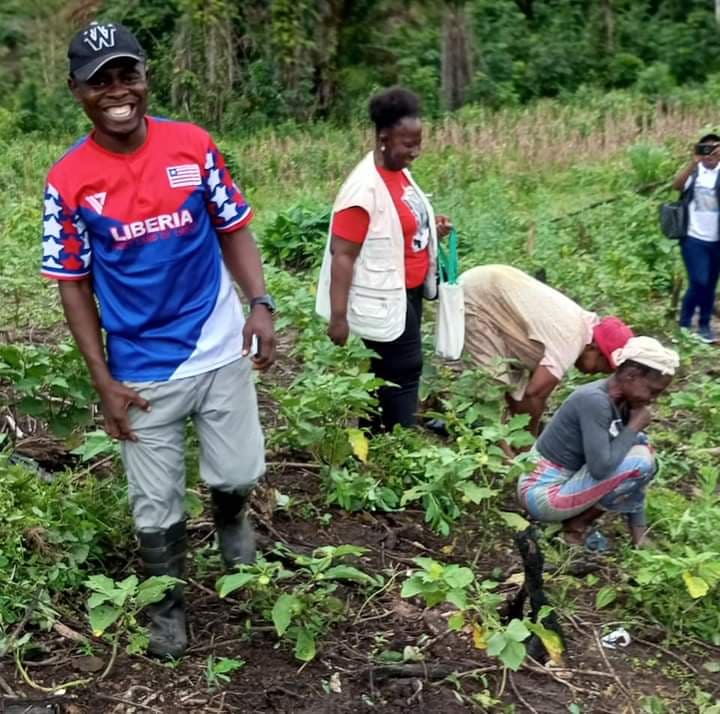By James Lehmer Hiama, Jr.; 0770-334857; hiamajames@gmail.com
IPNEWS-Monrovia: As agriculture remains one of the major sectors to busting the economic environment of Liberia, the executive director and founder of a local non-governmental organization named ‘feeding Liberia (FELA)’, Josephus M.C. Freeman has labelled agriculture as ‘one of the most valuable sectors to climate change.’
In a conversation with media practitioners over the weekend at the offices of the organization located at Barnersville Junction on the Japanese Freeway, the Executive Director disclosed that, farmers are doing the biggest job on earth. Putting food on the world’s table in these challenging times in the face of a fast-growing population and a rapidly changing climate.
According to Director Freeman, the aims and objectives of Feeding Liberia (FELA), is to promote agriculture throughout Liberia, implement feeding programs which will enable each Liberian to produce food; as well as focus on education, health and among others. In furtherance, he noted that they are naturally stewards of the land and have been contributing to sustainable agriculture for generations and generations to come.

He, proffered that farmers need to balance ever increasing complexity-managing resources, people, and technology, climate and uncertainty in order to produce in an economically sound way; and has appreciated the World Bank which is committed to promoting climate-smart agriculture to help mitigate the impacts of climate change.
The Executive director, feeding Liberia, revealed that the World Bank-funded West Africa Agriculture Productivity Program (WAAPP) is distributing climate-smart crop varieties and technologies to 5.7 million farmers across West Africa. He mentioned, agriculture was ruined by the Ebola crisis in 2014-2015 in West Africa, and kept farmers off their fields, disrupted food production and resulted to severe food shortages.
He, however, informed that agriculture has taken 60 percent of Liberia’s population and accounted for 31 percent of Liberia’s 2021 real gross domestic product (GDP) which provides income for many households engaging in cassava, rubber, rice, oil palm, cocoa, or sugarcane production. Cassava and rice are the primary staple food crops. He said many households engage in cassava production than any other crop, however, most agriculture is on small scale, and overall agricultural productivity is low, due in large part to low-technology practices and lack of quality agricultural inputs.
Vulnerable to global food price volatility. Poorly integrated, the agricultural sector lacks basic infrastructure such as machines, farming equipment and tools, farm-to-market roads, fertilizers and pesticides, and food storage capacity. The main cash crops and foreign exchange earners are rubber, oil palm, cocoa, and timber.
Rubber is a dominant revenue generator, accounting for 12.5 percent of total export receipts in 2021. Estimates put the number of people employed by commercial rubber farms at 20,000 and number of smaller holders households involved in growing rubber trees at 35,000. Firestone natural rubber concession, covering almost 200 square miles is the largest conterminous natural rubber operation in the world and the biggest private sector employer in Liberia.

Appreciating the Ministry of Agriculture which is the government ministry responsible for the governance, management, and promotion of the agriculture sector in Liberia.
Liberia has a favorable climate and fertile soil for cocoa production, there has been substantial investment in the rehabilitation of cooperative and smallholder cocoa farms. The country’s international partners, such as the International Fund for Agriculture Development (IFAD), continues to invest in cocoa smallholder producer to improve livelihoods and raise incomes by modernizing cocoa farming, increasing production, and developing market access.
Small scale cocoa production will likely increase as farmers continue to reclaim and rehabilitate farms. As with the agriculture sector in general, smallholder cocoa farmers and local cooperatives suffer inadequate farm-to-market roads, lack of familiarity with measurement and quality standards, lack of storage facilities, and limited access to updated price and market information.






